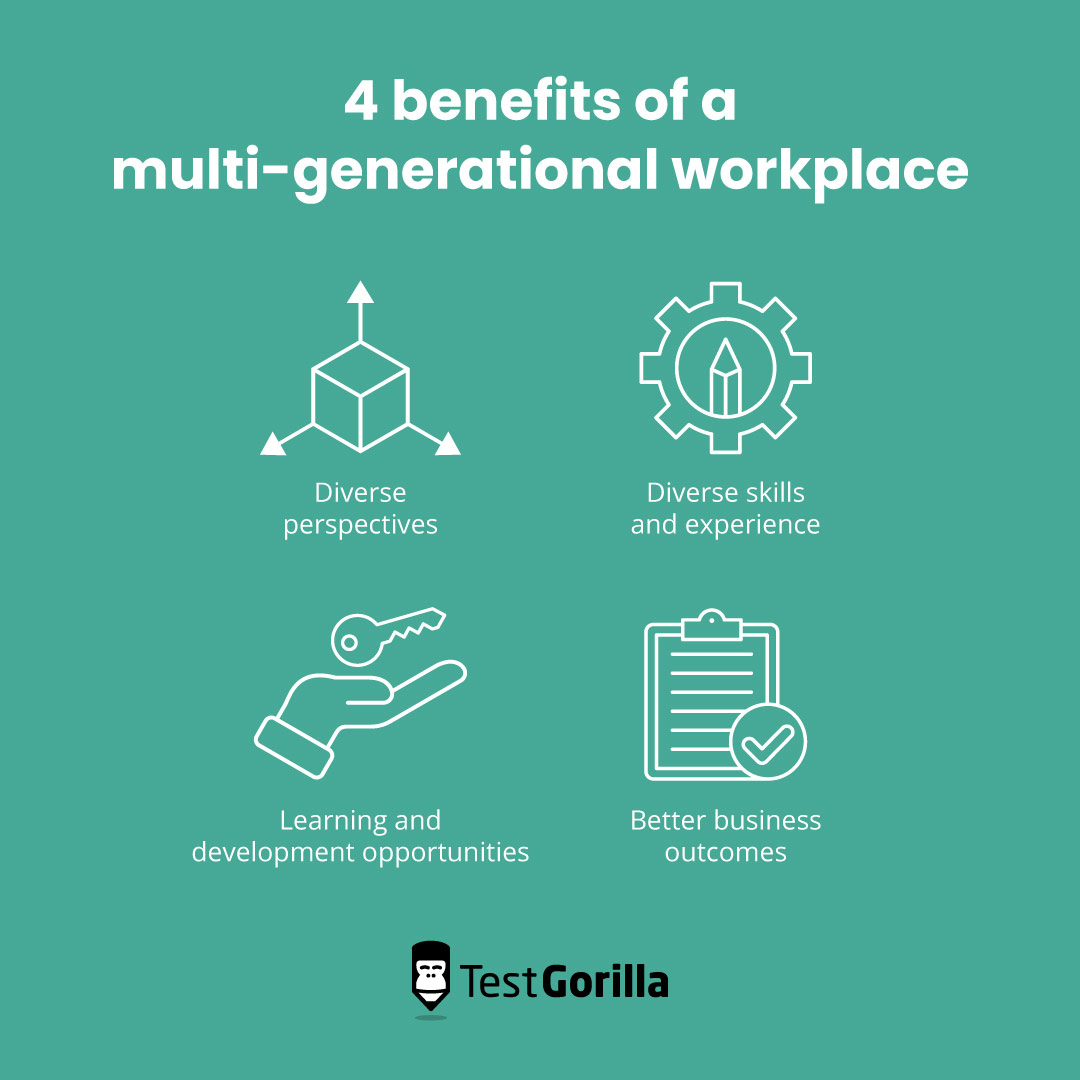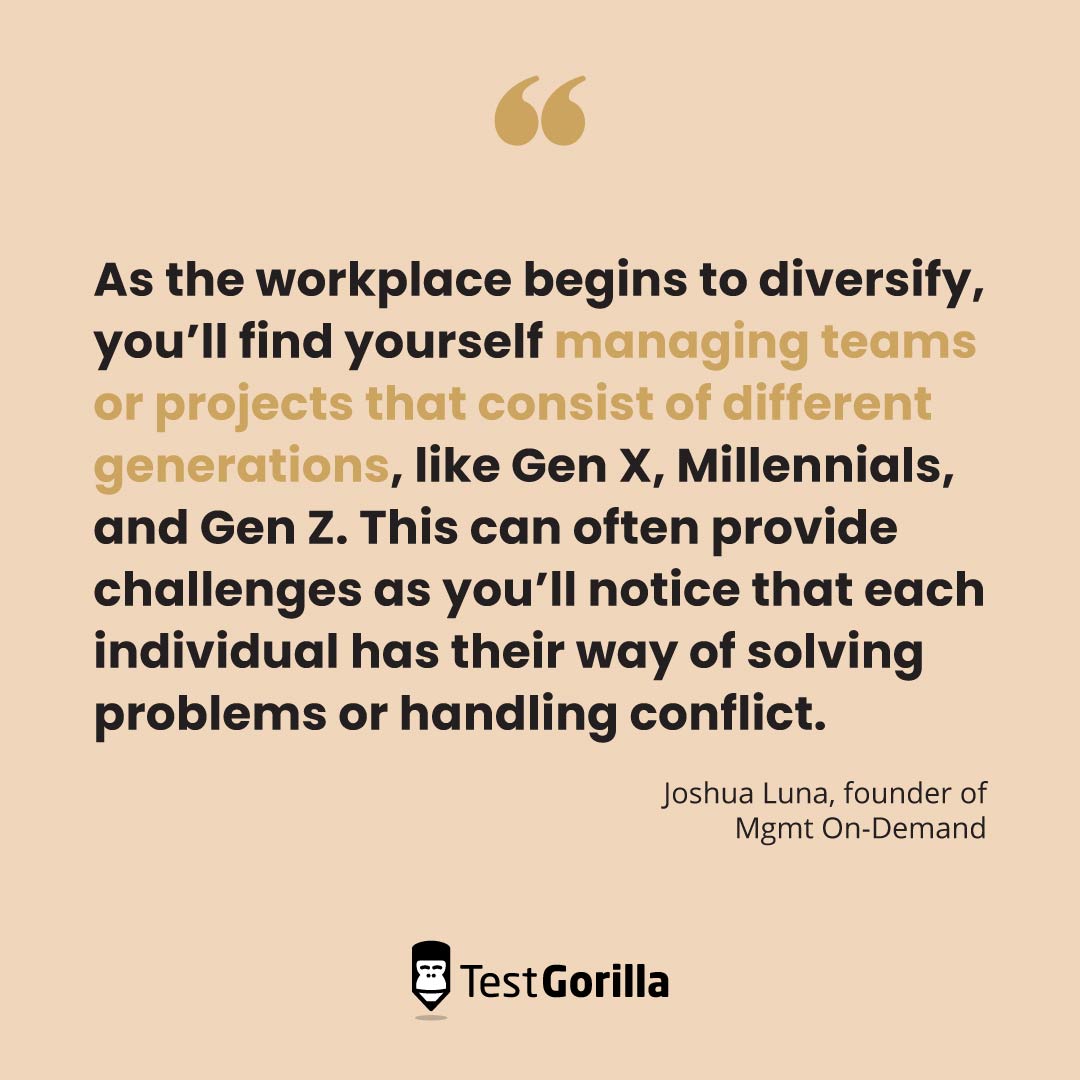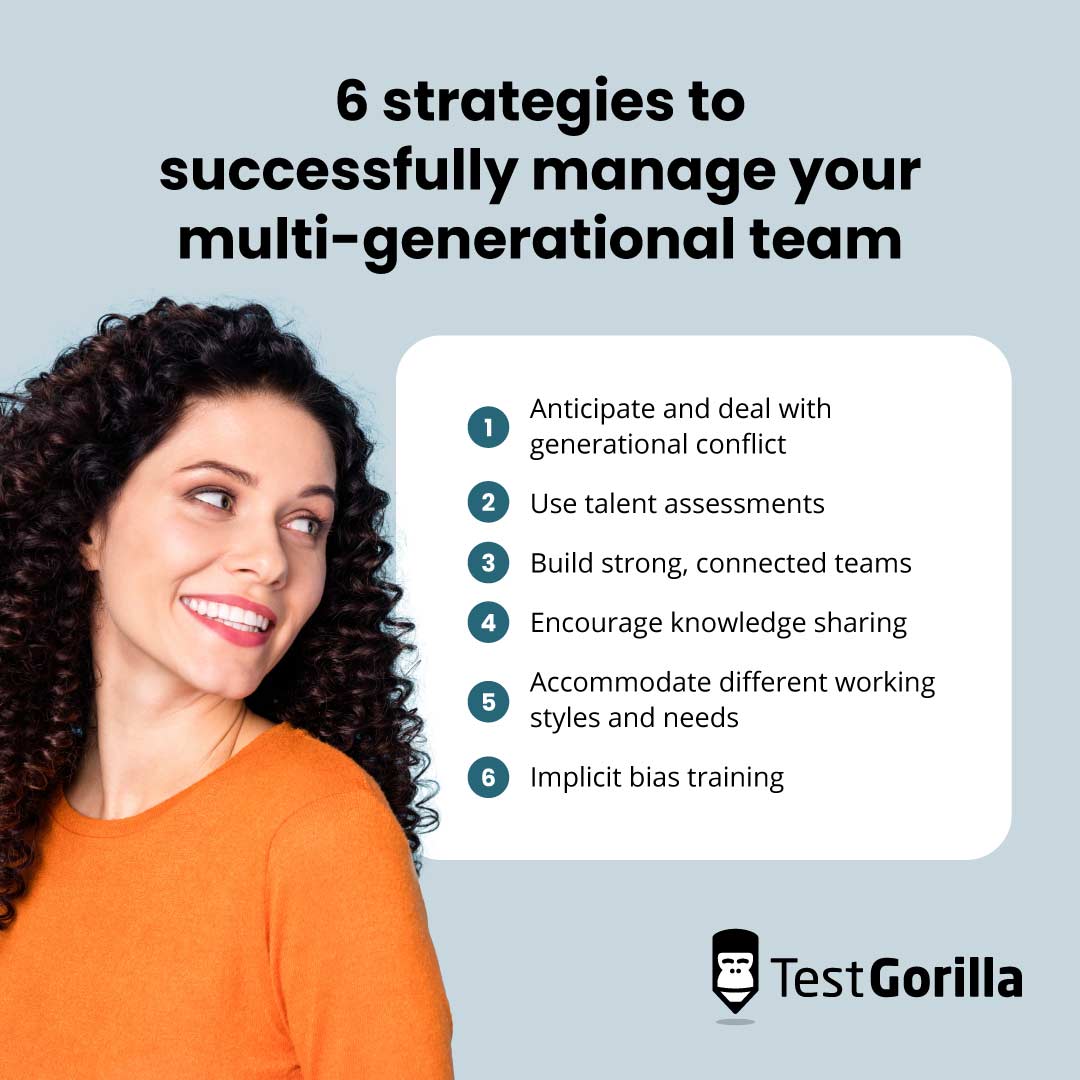6 strategies for managing a multi-generational team
People are retiring later than ever before, occupational mobility is on the rise, and workforces are becoming more diverse.[1] It’s now technically possible to have four generations (soon to be five!) on the same team.
A multi-generational workforce brings diverse perspectives, skills, and experiences to the table, which can result in more creativity and innovation. It also offers opportunities for knowledge exchange, mentoring, and coaching, which help improve employee skill sets and resilience.
However, managing multi-generational teams comes with its own challenges. For example, navigating different career expectations, values, and communication styles.
In this post, we’ll explore the benefits and challenges of a multi-generational workplace and outline some best practices to help you hire and retain them successfully. We’ll also look at how skills-based hiring lets you hire and develop the right people for your open roles, regardless of age.
What are the benefits of a multi-generational workplace?
A diverse workforce can transform your business by improving productivity, decision-making, and problem-solving. When managed successfully, age-diverse teams can be more dynamic, higher performing, and happier than their more homogeneous counterparts.[2]
When teams span multiple generations, you also get benefits like:
Diverse perspectives. Every generation has unique life and work experiences and ways of looking at things. This diversity of input drives creativity and innovation, makes for better problem-solving, and offers a broader understanding of customer needs.
Diverse skills and experience. Younger generations often possess up-to-date technological expertise and fresh insights. Older workers bring extensive industry knowledge and leadership or people management skills. Having individuals of different generations pool their skills enhances collaboration, team performance, and overall productivity.
Learning and development opportunities. The more diverse your teams are, the more opportunities there will be for mentoring, coaching, and peer learning. Seasoned professionals can pass on their expertise to younger colleagues, while younger team members can help others pick up tech skills and understanding of younger markets. This helps create a culture of continuous learning that benefits both your teams and your business.
Better business outcomes. The combination of different perspectives and skills helps your organization stay agile and competitive, seize opportunities, and respond better to changing market demands. This helps them make better decisions and can lead to improved performance and success.
However, hiring, nurturing, and managing such teams comes with its challenges. Let’s take a look at those, and how you can overcome them.
What are the challenges of a multi-generational team?
“As the workplace begins to diversify,” says Joshua Luna, founder of Mgmt On-Demand, “you’ll find yourself managing teams or projects that consist of different generations, like Gen X, Millennials, and Gen Z. This can often provide challenges as you’ll notice that each individual has their way of solving problems or handling conflict.”
An awareness of the challenges will allow you to tailor your management efforts accordingly and retain your people.
Some of the roadblocks you might need to overcome include:
Different career expectations and priorities. Individuals on multi-generational teams represent different life stages, which means they have different life priorities and professional development goals. For example, younger employees may seek rapid advancement, while older counterparts may value stability or work-life balance.
Different working and communication styles. Generational differences can shape individual preferences regarding how people approach and carry out their work. For example, while some may prefer in-office interactions, others might rely more on video conferencing or instant messaging. Your people can also have different attitudes toward work and organizational culture – from work ethic to leadership preferences.
Bias and stereotyping. Older employees may face ageist stereotypes such as being resistant to change or lacking in tech skills. Younger individuals may be seen as inexperienced or lacking in people skills, commitment, or loyalty to the company. These stereotypes can undermine trust and hinder the recognition of individual strengths and contributions. Preconceived notions and age-related bias can also hamper teamwork and efforts to establish psychological safety and a positive team culture.
When managing workers of different ages, “it can be easy to resort to analyzing trends or clusters of similarity between employees,” Joshua says.
”It’s natural to want to group similarities. That’s how our brain processes information for us to sift through it quickly and make decisions. However, this approach rarely yields positive results when working with people.”
For Joshua, there are no shortcuts to managing different types of individuals. There are, however, some strategies you can adopt to help you along the way. Let’s take a look at those next.
The best insights on HR and recruitment, delivered to your inbox.
Biweekly updates. No spam. Unsubscribe any time.
6 strategies to successfully manage your multi-generational team
Successfully managing multi-generational teams relies on knowing how to meet the unique challenges they pose. Here are six ways to empower everyone on your team to do their best, regardless of their age.
1. Anticipate and deal with generational conflict
When conflicts arise due to differences in values, communication styles, or approaches to work, it can create a hostile and divided work environment. Well-meaning but inappropriate comments, politically incorrect language, or outdated views, for example, can alienate workers from a different generation and hurt team dynamics.
By proactively identifying and resolving conflicts before they escalate, you can foster a sense of belonging, trust, and empathy among all team members. Successfully managing inter-generational conflict also showcases your organization's commitment to diversity and inclusion (D&I). This can enhance your company’s reputation and attractiveness to top talent.
To stop these conflicts in their tracks:
Promote awareness and understanding. Organize workshops, training sessions, or informational campaigns that raise awareness about generational differences and the potential for conflict. Encouraging employees to develop empathy and gain insights into each other's perspectives can preemptively mitigate tensions.
Foster cross-generational collaboration. Creating opportunities for different generations to collaborate and share experiences can help bridge gaps and build mutual respect, trust, and empathy. Mentorship programs, cross-functional projects, and even job-sharing opportunities can facilitate meaningful interactions and foster a sense of camaraderie.
Create psychological safety. This means establishing an organizational culture where everyone feels safe to take risks, ask questions, and share feedback without fear of the consequences. In a psychologically safe environment, your people are more likely to learn from each other, develop empathy, and resolve conflicts more easily.
2. Use talent assessments
What gets Millennials through the door won’t necessarily motivate and empower Gen Z, so your hiring practices need to appeal to all age groups. You also want to avoid hiring people based on stereotypes, only for them to turn out not to be the right fit. For example, it’s tempting to think a younger candidate will have the digital skills you need, but you might be overlooking a better qualified older person. Similarly, you might hire an older person with years of experience only to find their motivation for the job is low.
Using talent assessments during recruiting lets you assess people based on skills rather than qualifications or experience. This means you can hire the right people for your open roles, no matter what age they are. You can also use talent assessments to identify and close skills gaps and offer continuous employee development. This helps maximize each individual’s potential and drives organizational success.
Talent assessments also help you find people who are the right fit for your multi-generational organization. For example, a Culture add test lets you find employees who align with your team and company values and will add to your multi-generational culture. Similarly, a Motivation test helps you hire candidates who are enthusiastic about the job and motivated to help your organization achieve its goals.
You can also use a Leadership and people management test to find managers with the right soft skills to successfully nurture age-diverse teams.
Learn more: In our 2022 State of Skills-Based Hiring report, we found that 91% of employers who adopted skills-based hiring saw an increase in workplace diversity. More than 72% of people hired using this method were also happier in their roles and more likely to stay longer.
3. Build strong, connected teams
Enabling your people to build deeper relationships helps foster a stronger sense of understanding and appreciation among them. This helps minimize misunderstandings and avoid or resolve conflicts.
Well-connected teams are also less likely to fall victim to attrition and burnout. In fact, employees with less feeling of belonging have 313% stronger intentions to quit and 176% higher likelihood of seeking a job elsewhere than those who feel they do belong.
Here are some ways to help your people find common ground and connect with each other:
Establish and live strong shared values. These might include kindness, respect, empathy, and trust. These values guide behavior and help people make decisions that are best for the team. For example, if someone finishes early, they’ll be more likely to offer to help their coworkers. By setting and modeling values that promote team connection, you can create a foundation for inclusivity and belonging within your multi-generational teams.
Run team-building exercises. These give your people the opportunity to pool their knowledge, solve problems, and get to know each other on a deeper level without the stress of the work environment. For example, you can organize interactive workshops, games, or exercises that encourage individuals to share their experiences, values, and perspectives. Just remember, team-building events might not be everyone’s cup of tea, so don’t forget to create opportunities for connection outside of these events as well. For example, by using apps like Donut on Slack to randomly pair people for conversations.
Use affinity or employee resource groups. These groups offer a safe space for individuals to connect with others who share similar backgrounds, aspirations, or identities. This helps foster a sense of belonging and allows diverse voices to be heard.
4. Encourage knowledge sharing
When people can exchange knowledge, they’re more likely to notice and appreciate what others bring to the team. Knowledge sharing also promotes a positive team culture, encourages open dialogue, and helps break down silos. This enables teams to tackle challenges in a more creative, agile way.
Here are some ways you can encourage knowledge sharing:
Create collaborative and cross-functional projects. These require team members from different generations and departments to work together and share their expertise. This helps your people grow and learn in a practical context while building relationships with others from different generations and backgrounds.
Organize dedicated knowledge-sharing sessions. In these, team members can present on topics of their expertise, share best practices, or provide insights from their unique experiences. This structured approach encourages active participation and lets your people focus on one specific topic at a time – and learn from each other.
Facilitate peer-to-peer learning. Encourage team members to share their knowledge and skills with each other. You can do this through informal lunch-and-learn sessions, skill-sharing workshops, continuous feedback loops, or mentoring circles where individuals teach and learn from their coworkers.
Promote documenting and sharing lessons. Always document learnings from projects or experiences through post-project evaluations, case studies, or internal reports. By sharing these insights, you can ensure valuable knowledge doesn’t get lost and is always available for team members to refer to.
5. Accommodate different working styles and needs
Different generations may have distinct preferences when it comes to how they work and communicate. By accommodating these differences, you can create an environment that encourages collaboration and productive dialogue between all team members.
Team members are more likely to engage and contribute effectively when they feel their preferred styles are respected and valued.
There’s no one-size-fits-all solution when it comes to managing diverse teams, so start by having conversations with your people to find out what’s important to them.
Some other ways to accommodate differences in working styles and needs include:
Offer flexible working arrangements. This allows those who prefer to work remotely or hybrid to be more productive and strike a better work-life balance. For example, those with childcare responsibilities can take ownership of their work, look after their kids, and adjust their schedules to align with their most productive times of the day.
Empower managers to tailor assignments. These should have enough flexibility to adapt to each person’s working preferences. For example, If you know your Traditionalists value structure and stability, give them clear, well-defined roles and responsibilities that let them leverage their expertise. If your Gen X workers prioritize autonomy, allow them to manage their time and give them a degree of decision-making authority. When managing digital natives, keep them engaged by giving them projects that harness their tech skills. Remember to avoid stereotyping, though. Always ask questions to find out what people prefer.
Follow up on 1:1 meetings. It’s especially important to do this when these meetings involve relationship building, setting expectations, or discussing developmental goals, as not everyone is comfortable updating you on their progress without being asked. “Don’t just ‘one and done’ these meetings,” Joshua says. “Make sure you follow up on initial discussions and… be the first one to start a conversation. Regularly discuss wins or any progress they are making towards their goals, regardless of where they are in their role.”
Implement effective communication channels. Establish various channels that cater to different communication preferences and styles across generations. For example, older generations might prefer face-to-face meetings or calls, while younger workers tend to lean toward instant messaging. Encouraging open dialogue, active listening, and feedback loops can also help prevent misunderstandings and promote effective communication.
6. Implicit bias training
Implicit bias training raises awareness and challenges unconscious biases that can influence our perceptions, judgments, and interactions with others.
By addressing implicit biases, you can promote a more inclusive and equitable work environment where team members from different generations feel valued and respected.
Here are some ways to get started:
Conduct interactive workshops. Provide education on implicit bias, its impact, and strategies to mitigate it. Collaborate with external trainers or leverage internal resources to deliver training sessions focused on generational biases. These workshops can include case studies, discussions, and interactive exercises to encourage self-reflection and learning.
Develop scenario-based training modules. Use these to highlight common biases in the workplace, specifically those related to generational differences. Provide examples of scenarios where biases may come into play, and guide participants on how to recognize and overcome them.
Organize role-playing exercises. These let participants actively engage in simulated situations involving generational biases. This allows them to experience the impact of biases firsthand and develop strategies to respond effectively. Don’t forget to gather feedback and promote further discussions following the role-playing exercises to facilitate deeper understanding and learning. To really appeal to younger generations, you could even consider using the metaverse for training.
Train HR staff and hiring managers. They need to know how to identify and address biases in the recruitment and promotion processes. This includes adopting standardized criteria, structured interviews, and diverse interview panels, as well as implementing blind screening techniques and skills-based hiring to reduce the impact of biases.
Skills-based hiring: The key to managing multi-generational teams
These days, you’re increasingly likely to have workers from four different generations in your organization. With this age diversity comes higher productivity, satisfaction, and retention levels, and increased creativity and innovation.
However, there are also challenges associated with hiring and managing people with varying expectations, beliefs, and working styles.
This means you should adopt a tailored approach to people management, career development, communication, and rewards and recognition. Additionally, you should address age-related stereotypes and inter-generational conflict before they can negatively affect your team culture.
To do this, follow our six strategies to manage multi-generational teams. For example, strategies include building strong, connected teams; encouraging knowledge sharing and mutual appreciation; and accommodating different working styles and needs. When you do this, your people will be more productive and likely to stick around longer.
Use skills-based hiring and talent assessments to make your company a fairer place to work for all your employees. Hiring based on skills, not years of experience or assumptions about proficiency, lets you hire people who are the right fit for your roles and team, and can make a positive contribution to your company culture.
Want to find the right people for the job, regardless of their age? Skills-based hiring saves time, reduces costly mis-hires, and maximizes ROI on hiring.
Check out our pricing page to find a plan that works for you.
Sources
“Future retirement ages.” OECD. Accessed July 10, 2023 Future retirement ages | Pensions at a Glance 2021 : OECD and G20 Indicators | OECD iLibrary (oecd-ilibrary.org)
“Good for business: Age diversity in the workplace and productivity.” OECD. Accessed July 10, 2023. 2. Good for business: Age diversity in the workplace and productivity | Promoting an Age-Inclusive Workforce : Living, Learning and Earning Longer | OECD iLibrary (oecd-ilibrary.org)
Thanks to Wristy, independent consultant, people leader, and advisor, for insights and contributions.
Related posts
You've scrolled this far
Why not try TestGorilla for free, and see what happens when you put skills first.

















